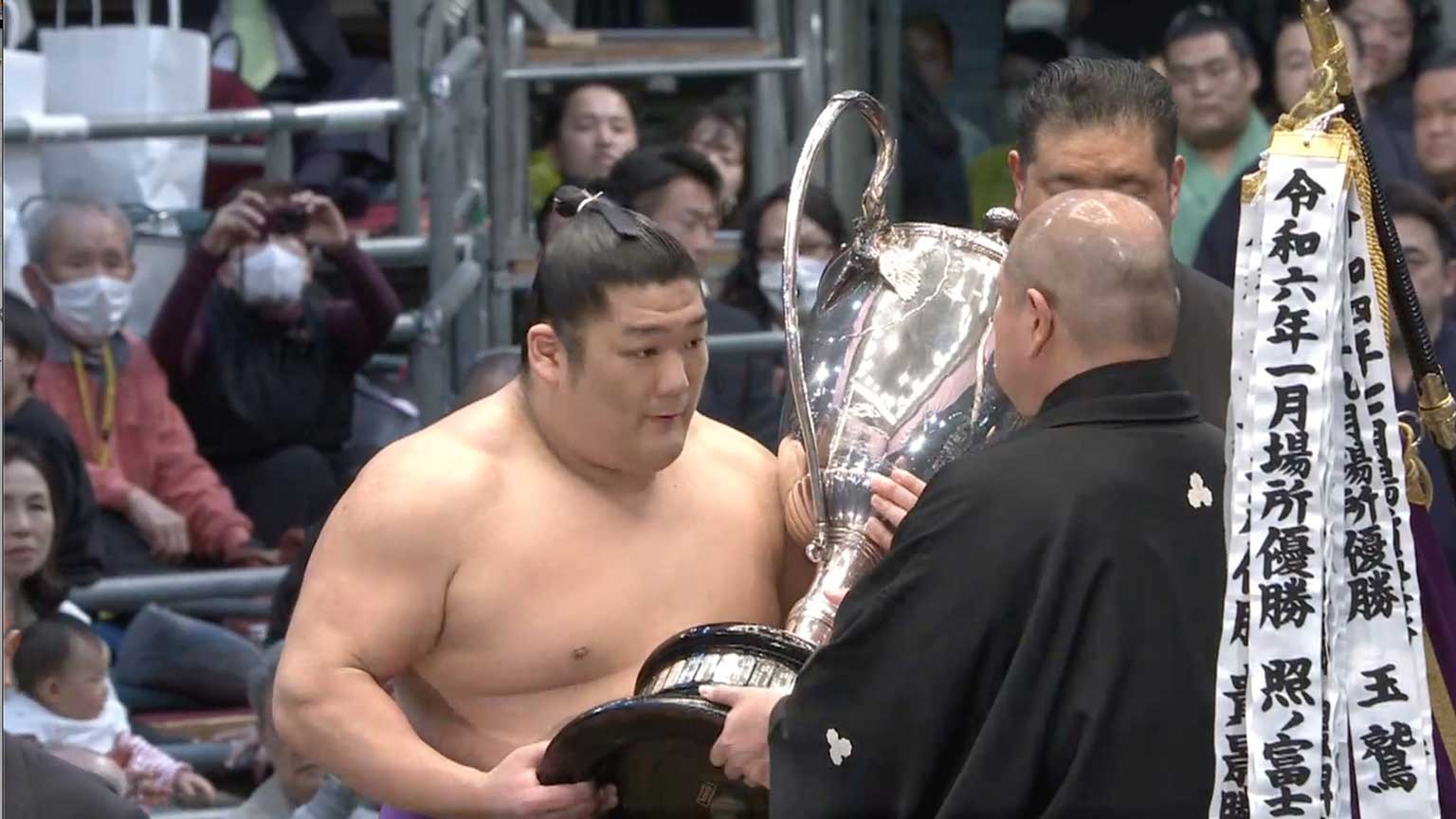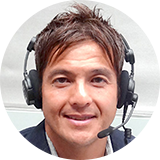Pent-up excitement
With the addition of a new Ozeki, Kotonowaka, the Banzuke official listing of ranks included the names of one Yokozuna and four Ozeki.
People in Osaka are known to be passionate sumo fans. Only one grand sumo tournament is held there each year, and tickets sold out soon after they went on sale. Folks in the box seats and in the stands were raring to see the top-ranked rikishi put on a show of strength.
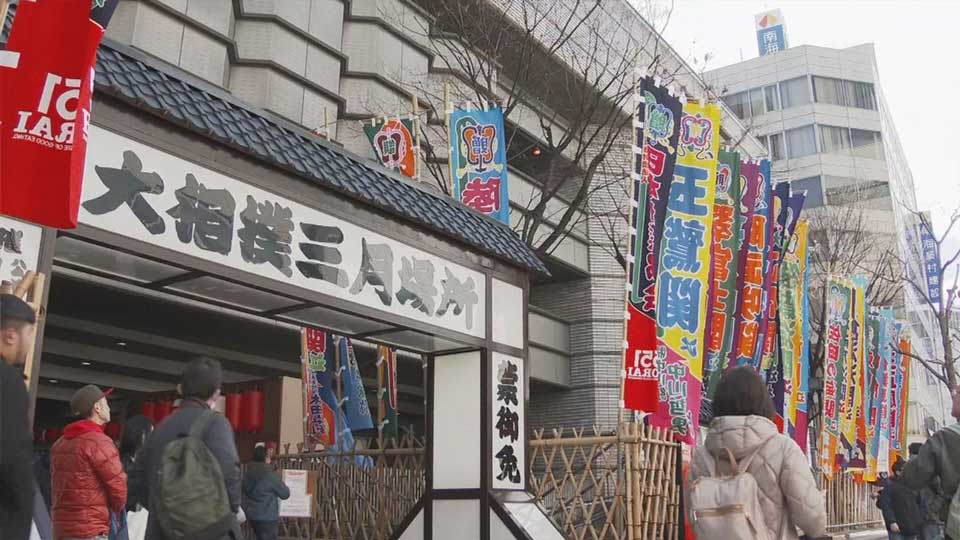
Failing to meet standards
Entering the competition, the undisputed top contender was the lone Yokozuna, Terunofuji. The 32-year-old was coming off his ninth championship in January. He's always said that winning ten is his goal, as a wrestler who wins double-digit championships is forever remembered as a "Great Yokozuna."
Greatness of that sort will have to wait for a while. Terunofuji was upset on the opening day. He bounced back in the two following matches with convincing victories, but then lost three in a row to Maegashira rank-and-filers. After suffering his fourth loss, he decided to stop embarrassing himself and pull out of the competition. He cited lower back pain as the main reason for his withdrawal. The sumo faithful in Osaka were disappointed to say the least. He ended the competition with a dismal 2 wins, 5 losses, and 8 absences.
He wasn't the only top-tier combatant failing to live up to his standing, though. Ozeki Kirishima was considered to be in line for promotion to Yokozuna, thanks to his consistency. Consistency came to a halt in Osaka, however. Kirishima seemed to lack power, stamina and concentration from start to finish. He ended up with a mindboggling 5 wins and 10 losses. He'll have to figure out what went wrong fast if he wants to redeem himself in the next tournament.
One more Ozeki I want to mention is Takakeisho. After posting a losing record in January, he entered the spring contest needing to post at least eight victories to maintain his rank. He did it, but just barely, collecting exactly eight wins. That's nowhere near what fans expect from a four-time tournament champion, though. A neck injury has been holding him back. But considering he's just 27, he should have a few more years of high-level performance in him, assuming his neck heals.
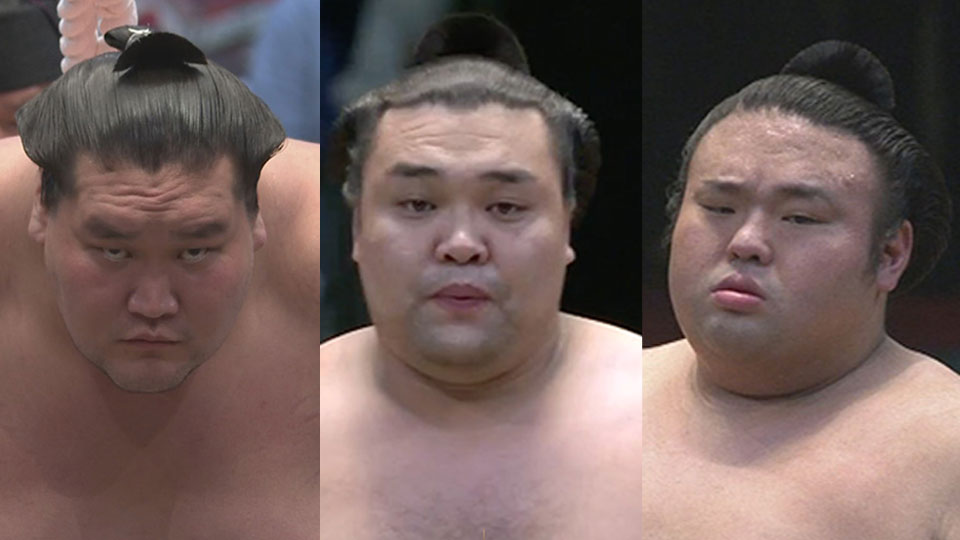
History in the making
So much for the negatives. Let's accentuate the positive. The Osaka tournament is often called the "Areru Haru Basho" or "Stormy Spring Tournament." Somehow, it seems to feature more than its share of twists and turns and upsets. And that's exactly what happened this time.
The man who made his presence felt from the outset was Takerufuji. He entered the tournament as the lowest-ranked wrestler in a field of 42 combatants in the top Makuuchi division. Somehow, he refused to stay in his place, winning his first 11 bouts from the opening day. That tied former Yokozuna Taiho's record of consecutive wins by a newcomer to the top division.
Takerufuji put the pedal to the metal, and after 13 days, he was the sole leader with 12 wins and 1 loss. The closest wrestlers were Ozeki Hoshoryu and Maegashira Onosato, each with 10 wins and 3 losses. That gave Takerufuji a comfortable two-win lead with just two days left.
Takerufuji entered Day 14 with a chance to clinch the championship. He fought former Ozeki Asanoyama, moving into a chest-to-chest position. Asanoyama seized his favorite right hand inside grip, marched forward and handed Takerufuji his second loss. Immediately after the match, something was obviously wrong with Takerufuji. The rookie was hobbling as he made his way back to the dressing room in pain. He was carted off in a wheelchair and transported to a hospital in an ambulance. Everyone wondered: How serious is his injury and will he be able to compete the next day for the championship?
Answering the questions, Takerufuji showed up on Day 15, walking on his own power. His right ankle was heavily taped for protection, but there was no way he was going to miss the biggest match of his career.
Takerufuji's Day 15 opponent was Gonoyama, who had already racked up an impressive record of 10 wins. Takerufuji stopped Gonoyama's initial charge with a face slap. He then gained a firm right hand outside grip and fiercely attacked. Gonoyama pushed back, but Takerufuji remained on the offensive, shoving Gonoyama back and out of the ring to claim the match and the Emperor's Cup.
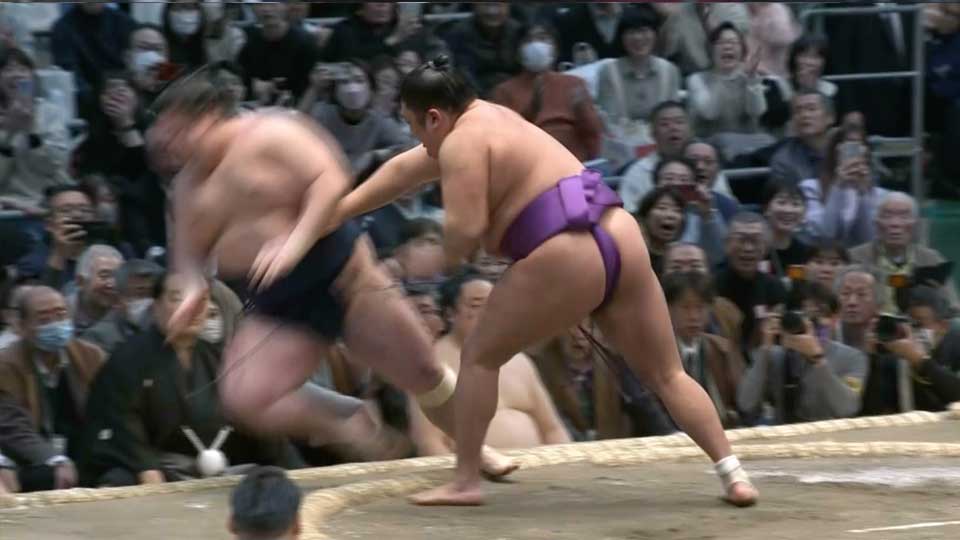
With the victory, Takerufuji becomes only the second rookie in history to win the top division championship. The previous one was Ryogoku, who did it way back in 1914 May. Furthermore, by winning a championship in his 10th tournament since making his pro debut, Takerufuji bettered Ryogoku's record of achieving it in 11 tournaments.
During the victory ceremony, the rookie said that despite being injured and physically strained, he felt it was the responsibility of a sumo wrestler to step onto the ring for all 15 days. He also wanted to prove to himself that he could win the championship. He said that while records are important, what he really wanted was to leave a lasting impression in everyone's minds. That he did.
I want to share a behind-the-scene story Takerufuji revealed the day after the tournament. He said that after the 14th day, he conferred with his stablemaster and decided not to participate on the final day to avoid worsening the injury. However, following a conversation with his stablemate, Yokozuna Terunofuji, he changed his mind. Terunofuji told him, "You can do it. If you don't compete tomorrow, you'll regret it for the rest of your life." Those words from the Yokozuna seemed to ease the pain in his leg. Takerufuji said his right ankle still hurt, but he felt a surge of courage and determination to fight on the final day.
What an amazing accomplishment. Way to go Takerufuji! At the risk of blowing my own horn, I'd like to say that I predicted Takerufuji to be one of the main contenders for the spring tourney on NHK World-Japan's GRAND SUMO Preview. The program aired two days before the Osaka contest. I'm glad I was able to prove what I'm talking about when it comes to sumo.
Special prize winners
Sumo elders never forget to praise and reward those who excel during the 15-day competition. This time, though, they only picked two rikishi for prizes.
One of them is the obvious choice: tournament champion Takerufuji. He left Osaka with the Emperor's Cup, and all three special prizes: Outstanding Performance, Fighting Spirit, and Technique. Takerufuji is the first wrestler in 24 years to sweep all three. He better make some room in his trophy case because it's going to get crowded.
Onosato is the other rikishi who didn't go home empty-handed. The 23-year-old relative newcomer picked up two special prizes: Fighting Spirit and Technique. Onosato has stayed in contention until the final moment for two consecutive tournaments. Next time, he's hoping to match what Takerufuji was able to accomplish this time.
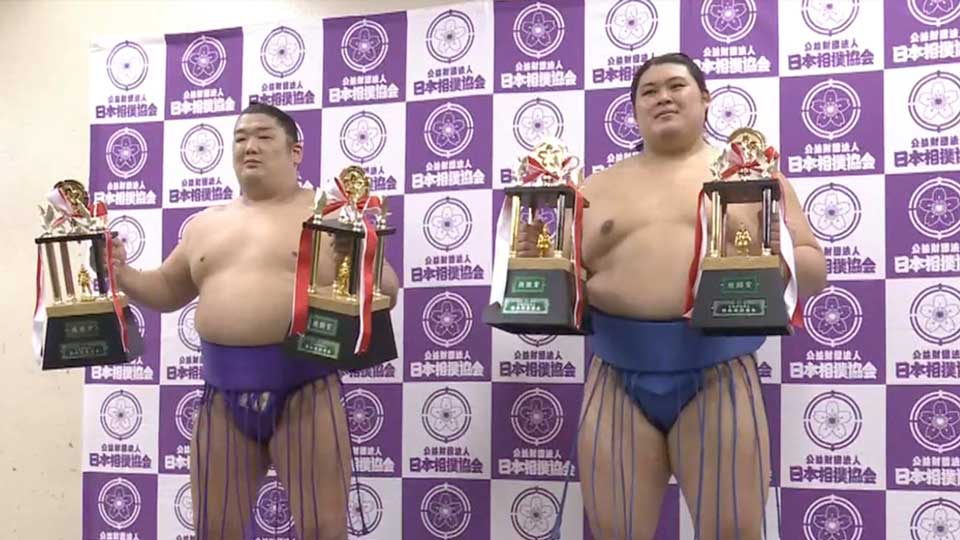
Step in the right direction
Starting from this tournament, an emergency medical crew has been stationed near the dohyo to provide immediate care for sudden illness or injury. The Sumo Association recognized the importance of having someone with specialized knowledge around at all times. I've always been an advocate of doing this. So, even though it took a while, I'm glad the Association made it happen.
Trouble in Miyagino Stable
The future of the Miyagino Stable is a major concern in sumo circles.
Stablemaster Miyagino, the former Yokozuna Hakuho, is being held accountable for an episode of violence that occurred in the stable, caused by former Makuuchi rikishi Hokuseiho. Miyagino has been suspended from coaching, and Hokuseiho has retired.
The Sumo Association also demoted Miyagino two ranks in the stablemaster hierarchy and a 20 percent salary reduction for three months.
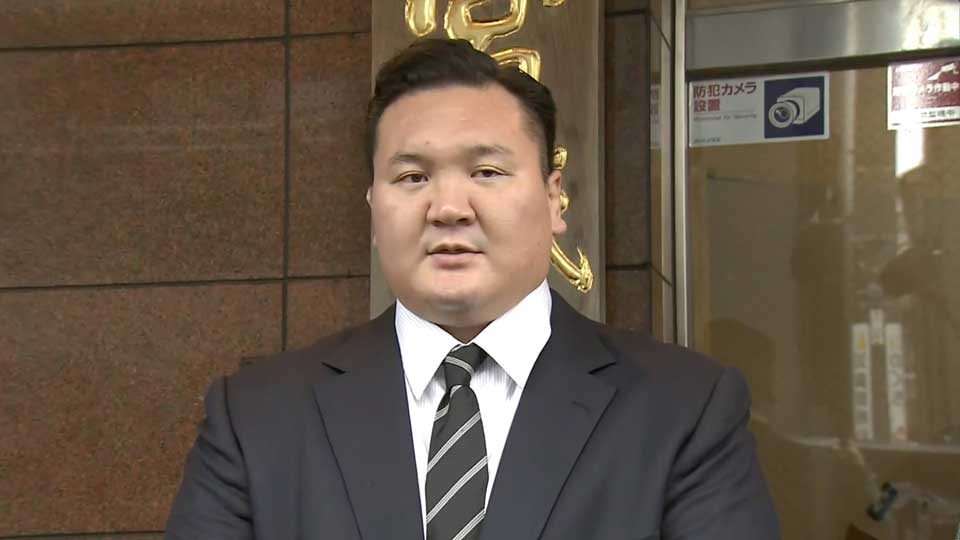
The Association reprimanded him for the following reasons: 1) he failed to address Hokuseiho's violent behavior and other misconduct towards other rikishi in the stable despite being aware of it, and 2) he did not report this violence issue to the Association. It became aware of the situation through social media posts which prompted it to investigate.
Tamagaki Oyakata, who is the former Komusubi Tomonohana, served as interim master of the Miyagino Stable for the Spring Tournament. It is believed that the Sumo Association will determine the future of the Miyagino Stable and its members soon.
It goes without saying that the victims are the stable's wrestlers. They deserve an environment in which they can focus on training and tournaments.
May Tournament sneak preview
Yokozuna Terunofuji once again provides much of the drama as we look toward the May Tournament. Will he compete? He says he'll take part in the April provincial exhibition tour and prepare himself for May. I hope things work out that way.
My other concern is Ozeki Kirishima. He went 5-10 in Osaka. As I mentioned earlier, he looked lethargic and lacking in confidence from start to finish. His stablemaster is reaching the mandatory retirement age of 65, and the stable will close down in early April. Kirishima is expected to transfer to the Otowayama Stable, run by former Yokozuna Kakuryu. Maybe the change of venue will allow him to regain his composure.
In Osaka, the newly promoted Ozeki Kotonowaka earned a passing grade, in my opinion. He finished with 10 wins and 5 losses. With all the events he had to attend soon after attaining the Ozeki rank in late January, he must have found it challenging to fully prepare for the March Tournament. Now that all the hubbub is behind him, I have a feeling he'll perform much better in May. Kotonowaka is expected to inherit his grandfather's ring name, Kotozakura, soon. Kotozakura was a Yokozuna who won five top division championships. Kotonowaka and his stablemaster are still talking over what name he'll use in May. His stablemaster, by the way, also happens to be his father. It's all in the family, and I have a feeling they'll be feeling happy about how things go in the next tourney.
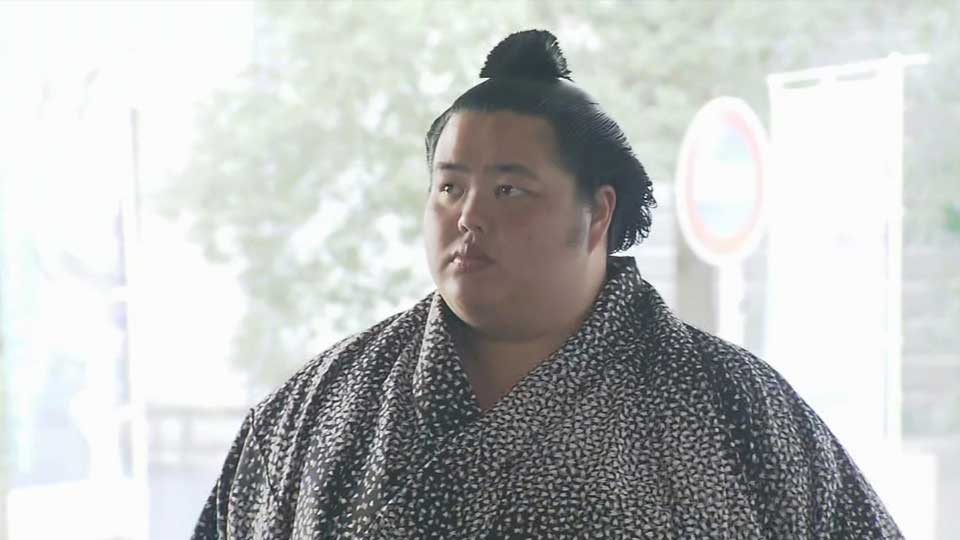
The winner of two special prizes, Onosato, must have left Osaka with mixed feelings. Sure, he was happy about receiving multiple prizes and the wrestler who defeated him went on to win the Emperor's Cup. No shame here. Nonetheless, I'm sure it was gut-wrenching for Onosato to see Takerufuji embracing the coveted cup on the final day. I suspect that result has elevated Onosato's motivation and that he'll be in contention again in the upcoming competitions.
As for the man of the hour, Takerufuji, if he can fully recover and compete in the May Tournament, he should be in contention for another championship. Wrestlers from the same stable don't fight one another, except in a playoff for the championship. After 15 regulation bouts, if two or more combatants end with the same record, they'll be up against each other, no matter where they come from. So, one scenario is Takerufuji facing his stablemate, Yokozuna Terunofuji, in a playoff for the Emperor's Cup. Just thinking about it makes me excited.
The next Grand Sumo Tournament gets underway on Sunday, May 12, in the Kokugikan, the home of sumo, in Tokyo.
Kanjin-Ozumo
Finally, I'd like to tell you about an upcoming special event. Kanjin-Ozumo will be held at the Kokugikan on April 16, with the purpose of supporting recovery efforts for the Noto Peninsula Earthquake that occurred this New Year's Day. All admission fees will be donated to the affected areas.
Kanjinzumo is typically held to raise donations for construction and repair of temples, shrines, and other buildings of that sort. They were quite common during the Edo period.
The upcoming event is the first of its kind in 62 years. I believe that sumo should play a role in offering a helping hand to those in particular need, providing courage and strength. I'm looking forward to being there to see the joyful faces of the people who haven't had a lot to be happy about of late.
